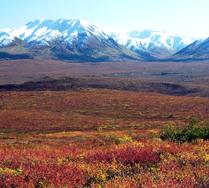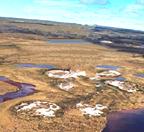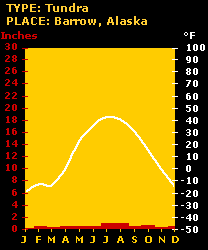|
Arctic
Tundra
 Arctic
tundra is found across northern Alaska, Canada, and Siberia. This
biome has long cold winters and short cool summers. The Arctic tundra
has low precipitation (less than 10 inches per year) and dry winds.
These conditions make the Arctic tundra a desert-like climate (see
climograph). Arctic
tundra is found across northern Alaska, Canada, and Siberia. This
biome has long cold winters and short cool summers. The Arctic tundra
has low precipitation (less than 10 inches per year) and dry winds.
These conditions make the Arctic tundra a desert-like climate (see
climograph).
One unique characteristic
of the Arctic tundra is permafrost--ground that is permanently frozen.
Because the permafrost has no cracks or pores, nothing can penetrate
it--neither plant roots nor water. The surface layer above the permafrost
thaws each summer. This layer is called the active layer. Thickness
of the active layer depends on its location in the tundra. The more
northerly the location, the thinner the active layer is.
 Curiously,
during the summer Arctic tundra is characterized by lots of surface
water. When snow melts, the water percolates through the active
layer but is unable to penetrate the permafrost. Since the water
has nowhere to go, the active layer becomes saturated and pools
of water form on the surface. Another characteristic of the Arctic
tundra is the limited amount of sunlight it receives due to the
position of the Sun in the sky. Depending on the latitude, the Sun
can remain below the horizon for up to 2 months, leaving the Arctic
tundra in darkness. Although the sun remains in the sky 24 hours
a day during the summer, it stays close to the horizon and provides
only low intensity sunlight. Photos
© 2000-www.arttoday.com Curiously,
during the summer Arctic tundra is characterized by lots of surface
water. When snow melts, the water percolates through the active
layer but is unable to penetrate the permafrost. Since the water
has nowhere to go, the active layer becomes saturated and pools
of water form on the surface. Another characteristic of the Arctic
tundra is the limited amount of sunlight it receives due to the
position of the Sun in the sky. Depending on the latitude, the Sun
can remain below the horizon for up to 2 months, leaving the Arctic
tundra in darkness. Although the sun remains in the sky 24 hours
a day during the summer, it stays close to the horizon and provides
only low intensity sunlight. Photos
© 2000-www.arttoday.com

Back
| Next
|











